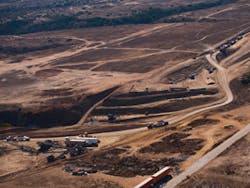Two construction-site stormwater management experts who spoke with Stormwater note that several years have passed since NPDES Phase II requirements first became effective. Since that time, they say, knowledge of stormwater management minimum control measures on construction sites has increased, although there still is room for improvement.
It’s true that California is ahead of much of the country in most matters environmental. The state’s compliance with Phase II requirements is one of the foremost examples of it. However, it’s also true that California is ahead of the rest of an indebted country in the size of its budget deficit. The potential result of this financial situation is a gap between stormwater management standards and the actual enforcement of their adherence on construction sites.
In California, Phase II jurisdictions fall under the General Permit for the Discharge of Storm Water from Small Municipal Separate Storm Sewer Systems WQO No. 2003-0005-DWQ (Small MS4 General Permit). All permittees are required to develop and implement a stormwater management plan (SWMP) designed to reduce the discharge of pollutants through their MS4s to the maximum extent practicable. The SWMP is to be fully implemented by the end of the permit term or five years after designation for those designated subsequent to adoption of the general permit. Jeanne Duarte, QSD, QSP, ToR, CPESC, CISEC, of Storm Water Resources in Valencia, CA, points out that most Phase II jurisdictions in the state are located away from the coast, whereas coastal cities were covered by Phase I permits long ago. When NPDES Phase II requirements became effective in California in 2003, many cities that would have been considered Phase II were already covered by adjacent Phase I-permitted jurisdictions because they were connected in some way to a large MS4. As a result, relatively few jurisdictions in California are covered by a Small MS4 General Permit; these are mainly confined to the northern and eastern parts of the state, which are
more rural.
After Phase I permits became effective in 1990, Duarte says, smaller jurisdictions that were adjacent to Phase I jurisdictions began to be covered by Phase I permits. The Small MS4 General Permit covers cities and counties that have populations of 100,000 or less, compared with 100,000 or more for Phase I permitting. The small MS4 permit also covers what are called “nontraditional MS4s,” such as military bases, prisons, highways, and school districts, adds Duarte, who spent five years developing and managing the City of Santa Clarita’s Storm Water Management Program and helped to develop the Los Angeles County NPDES permit in 1996.
In most cases, the MS4 construction-site component is covered by the California Construction General Permit (CGP). Duarte points out that the CGP, which was revised in 2009, is more advanced than the old version and very clearly defines minimum control measures and minimum best management practice (BMP) standards. The new CGP has numeric total maximum daily load limits, Duarte notes. Before NPDES Phase II requirements became effective in 2003, the stormwater management requirements applied to construction sites of 5 or more acres. Duarte points out that many jurisdictions in Phase II areas did not have as advanced knowledge of stormwater management as in the rest of the state. “For the outreaching areas of California, this was entirely new and some had never heard of stormwater before 2003,” she says. Still, “Most of our developers and contractors have worked in Phase I areas, so it’s not unusual for them to come across BMP requirements for stormwater that they may not have seen in that area before but that they have seen somewhere in their operation.”
Phase II and California’s CGP
A major focus of the CGP is post-construction requirements, Duarte notes. The new CGP deals with post-construction impacts on projects that are not currently covered under Phase I or Phase II MS4s. Because of the collapse of the housing sector in recent years, Duarte says, contractors are more routinely working on sites of less than 5 acres and must pay heed to post-construction impacts on these sites. “There has been an impact on a lot of the smaller developers who are buying smaller lots and who never had to have a permit before,” says Duarte. “Our one-acre [requirement] hit back in 2003, so we have been doing this for eight years now and that transition is pretty well over. It was just a matter of bringing them up to the level of the five-acre sites. That is the majority of our projects right now.”
From what Duarte has seen, most cities fund stormwater management programs through their general funds. Some cities have been able to implement a stormwater utility that generates fees; however, in 1996, California passed Proposition 218, which prevents a municipality from implementing these without voter approval. Contractors have bridged the funding gap and, in fact, bear the brunt of the costs. According to Duarte, contractors must pay development fees that cover the costs of plan checking and inspections. Stormwater management plan checking costs range from $1,000 to $4,000 and inspection fees depend on the municipality–that is, whether the municipality incorporates stormwater into other inspection services. When this is not the case, inspections are funded completely through development fees, according to Duarte.
A tremendous amount of resources remain for Phase II cities from the Phase I implementation, according to Duarte. The minimum control measures and programs within the Phase II permit are very similar to the first iterations of the Phase I permits, she points out. However, collaboration among impacted cities does not occur as much in Phase II as it has under Phase I, she says, speculating that Phase I covers the majority of the state and Phase II efforts, while large, are not as significant as the Phase I implementation in the large coastal cities.
Adherence to Phase II has not been as successful as it could be, Duarte contends. For one thing, she says, there is very little oversight or enforcement in the more remote areas of California that are categorized as Phase II areas. Some Phase II cities that are in closer proximity to Phase I areas have probably been more successful because they have the advantage of seeing what has been done under Phase I. However, many small desert communities have not implemented programs to adhere to Phase II requirements as well as others have.
“The issue is that the state, being in the economic and fiscal state that it’s in, doesn’t have the resources or the funding to enforce a higher level, so they don’t,” says Duarte. “I guess they prioritize, and there are a lot of issues in California that the state water board deals with, including groundwater, drinking water, and everything else.” Duarte speculates that Phase II implementation in rural areas simply takes a lower priority than some of these other issues in such an economic climate.
Duarte recommends learning from previous experiences for purposes of achieving Phase II compliance. “Don’t reinvent the wheel,” she says. “There are many successful Phase I and Phase II programs currently underway, and using those programs as resources for the development or implementation of your program can save you a lot of time and money.”
Methodical Enforcement
Enforcing Phase II standards is not much of an issue in the city of Griffin, GA, where contractors can be fined as much as $10,000 for noncompliance with permit requirements, according to Brant Keller, the city’s director of public works and utilities. The city uses a methodical approach to ensuring compliance on construction sites that includes development of a database that tracks construction projects.
Keller reports that the contractor must submit a stormwater plan before a project kicks off and a pre-construction meeting is held. The plans are reviewed by the city, which “redlines” them, or notes any problem areas. One of two environmental technicians, who have been on staff since 1998, then walks the site with the contractor to verify the effectiveness of best management practices. Keller notes that the city also requires contractors to be bonded for the cost of erosion and sediment control.
One action his department took that Keller deems critical was to meet with the municipal court judge and explain the Phase II standards that required adherence. It would not do any good to try to enforce the standards unless the judiciary was on the same page, Keller explains.
Keller has personal experience with the effects that a lack of enforcement has caused in Georgia. He contends that the state’s 1975 Sedimentation and Erosion Control Act was largely ignored for nearly 20 years. The former public works director in Peachtree City, GA, recalls having to dredge about 3 feet of sediment from a large drinking water reservoir there during the 1980s. When he was hired in Griffin, he recalls that a new drinking water reservoir had to be constructed because the existing one was losing millions of gallons of capacity from sedimentation every year.
Since 2000, the city has run an erosion and sediment control test site and trains 30 to 40 municipal governments on how to implement minimum control measures correctly, Keller reports. The city also takes a hands-on approach to ensuring that contractors are using effective BMPs.
“It’s more of a team approach,” says Keller. “We’re not out there trying to cause anybody any financial harm, but we know what works and what doesn’t work. So when we sit down with the contractor, we can say that’s not going to work in this situation and this is what you’re going to put in. At the end of the day, it’s the city of Griffin that’s going to end up dealing with the sediment TMDLs, the blown-out channels, or the degradation of water quality.”
These efforts buttress state stormwater management training requirements for grading contractors. Keller says that his department shuts construction sites down if the grading contractor is unable to produce a card indicating that the contractor is up to date on the training.
Keller thinks that Phase II compliance is making progress in Georgia. In his travels around the state, he notes, “What we’ve seen is that we don’t have red streaks in streams [from red clay] anymore. We don’t see a bunch of loading in streams. What we’re requiring now is a turbidity level of 25 NTUs [nephelometric turbidity units] when runoff leaves a commercial project. We pretty much know that we’re not getting the loadings that we were getting before.
“It doesn’t take a rocket scientist to see what needs to be done,” concludes Keller. “It’s just a question of whether you have the funding to do it.”Jeanne Duarte can attest to how far ahead of the rest of the country California is in terms of adhering to NPDES Phase II requirements. It’s also useful to talk with one of the developers of regulations that were on the cutting edge in this area in North Carolina way back in the early 1970s.Mell Nevils, P.E., section chief, Land Quality Section, Division of Land Resources with the North Carolina Department of Environment and Natural Resources, points out that the state joined Virginia and Maryland in protecting several sounds when North Carolina’s Sedimentation Pollution Control Act of 1973 was put into effect. Nevils says that, back then, the act was very unusual in that it did not have a lot of prescriptive standards. Rather, it contained four major performance standards for erosion control plans: efficient buffers, sufficient erosion control and sediment control; and state approval of a sediment and erosion control plan for sites of more than 1 acre.
Nevils indicates that the state’s longstanding regulations made it easier to adhere to Phase II regulations a few years ago, and a construction general permit (CGP), most recently updated in 2007, includes requirements for an erosion and sediment control plan. The Sedimentation Pollution Control Act of 1973 does include some prescriptive standards, such as how quickly to get ground cover planted and 25- or 50-foot buffers for trout streams, depending on the situation. He also indicates that the process of incorporating effluent limitation guidelines (ELGs) for discharge points is going smoothly. The general permit is up for renewal in August 2011, and starting in August 2010, environmental interests, regulated interests, and city and county governments have been represented in getting the ELGs incorporated into the new general permit.
“Not everybody agrees on everything, but we have so far gotten a lot of consensus with all of the groups that have been involved in it,” says Nevils. “We’ve had homebuilders involved in it, large contractors, we’ve had big-box builders involved who do a lot of building—we’re getting reasonable consensus. When a regulatory organization puts out new regulations without getting input, you normally wind up having a lot of problems on the back end—lawsuits and things like that. We’ve been able to avoid a lot of that over the years.
“I think that North Carolina, especially since 1973, has made great strides in erosion and sediment control,” continues Nevils. “If you look at how construction sites looked back in the mid-’70s and what they look like now, there’s a world of difference. Over the years, we’ve made steady progress. Overall, I think that North Carolina has done a good job of controlling erosion, sedimentation, and other stormwater pollutants.”



